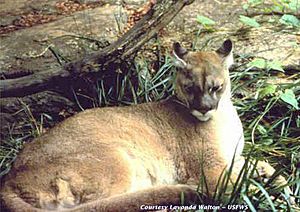Eastern cougar facts for kids
Quick facts for kids Eastern cougar |
|
|---|---|
 |
|
| Conservation status | |
| Scientific classification |
|
| Kingdom: | Animalia |
| Phylum: | Chordata |
| Class: | Mammalia |
| Order: | Carnivora |
| Suborder: | Feliformia |
| Family: | Felidae |
| Subfamily: | Felinae |
| Genus: | Puma |
| Species: | |
| Subspecies: |
†P. c. couguar
|
| Trinomial name | |
| Puma concolor couguar (Kerr, 1792)
|
|
| Synonyms | |
|
|
The Eastern cougar or eastern puma (Puma concolor couguar) was a type of cougar that once lived in northeastern North America. This group of cougars is now extinct, meaning they no longer exist in the wild.
The U.S. Fish and Wildlife Service, a government agency, first said the Eastern cougar was likely extinct in 2011. They officially removed it from the endangered species list and declared it extinct in 2018. Even though the Eastern cougar population is gone, cougars are still common in western North America. Sometimes, cougars from the west are seen in the areas where Eastern cougars used to live.
Contents
What is the Eastern Cougar?
The Eastern cougar was a large wild cat, just like other cougars or mountain lions. It was part of the same species, Puma concolor, but was considered a specific group or subspecies that lived in the eastern parts of North America.
Scientists use names like Puma concolor couguar to identify this particular group. The name helps them keep track of different populations of animals.
Why is the Eastern Cougar Extinct?
The main reason the Eastern cougar disappeared was because of humans. As more people settled in eastern North America, they hunted cougars and destroyed their habitats. Forests were cut down for farms and towns, leaving less space and food for the cougars.
By the 1930s, most scientists believed the Eastern cougar was gone. The official declaration of extinction in 2018 confirmed this sad fact.
Debate About Their Survival
For many years, there was a lot of discussion about whether the Eastern cougar still existed.
Sightings and Beliefs
Many people in eastern North America have reported seeing cougars since the 1960s. Some people strongly believe that a small group of Eastern cougars survived. They even formed groups to collect and investigate these sightings.
However, wildlife experts in 21 eastern U.S. states generally agree that the Eastern cougar population is gone. Canada's government says there isn't enough clear proof to say if they still exist.
Western Cougars Moving East
Biologists believe that most cougars seen in the east are either:
- Cougars that escaped from captivity (like pets or zoos).
- Wild cougars that have traveled all the way from western North America.
For example, in 2011, a cougar was hit by a car in Connecticut. Scientists checked its DNA and found it was a wild cougar from South Dakota, over 1,500 miles away! This shows how far western cougars can travel.
These traveling cougars are usually young males looking for new territory. For a population to truly come back, female cougars need to move and start families. So far, there's no clear evidence of breeding cougar populations in the eastern U.S. outside of Florida.
How Scientists Classify Animals
Scientists use a system called taxonomy to classify living things. This helps them organize and understand different species and subspecies.
Over the years, scientists have had different ideas about how to classify the Eastern cougar:
- In 1792, Robert Kerr gave the name Felis couguar to cougars in eastern North America.
- Later, it was called Felis concolor couguar.
- In 2000, some genetic research suggested that all North American cougars might be just one subspecies, Puma concolor couguar. This idea was included in a major scientific book in 2005.
- However, not all scientists agreed with this change. Some believed more research was needed, including looking at how the animals looked and behaved.
The U.S. Fish and Wildlife Service continued to use an older classification system. As of 2017, a group of cat experts recognized two main cougar subspecies: one for North America and parts of South America (P. c. couguar), and another for the rest of South America (P. c. concolor).
Genetic Research on Eastern Cougars
In 2015, students and scientists at Pennsylvania State University started a project to study the DNA of the extinct Eastern cougar. They took samples from old cougar skins preserved in museums.
They compared the DNA from these Eastern cougars to DNA from western cougars and Florida panthers. Their findings suggested that the Eastern cougars were not very different from cougars in the western U.S. This research supports the idea that all North American cougars might be part of a single subspecies.
Official Extinction
In 2011, the U.S. Fish and Wildlife Service began a detailed review of the Eastern cougar's status. After looking at all the information, they decided in 2015 that the Eastern cougar no longer needed protection under the Endangered Species Act.
On January 22, 2018, the Eastern cougar was officially declared extinct. This means it was removed from the list of endangered species because it was already gone.


